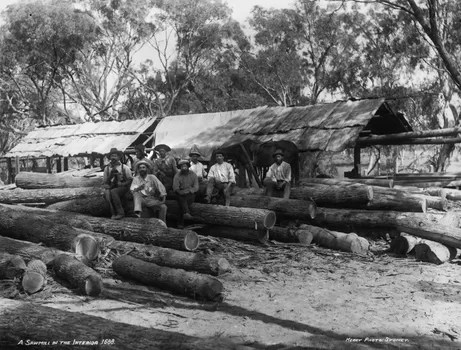A portable timber mill, also known as a portable sawmill, is a type of sawmill designed for easy transport to different locations. Unlike stationary sawmills, which remain fixed in one place, portable timber mills are mounted on trailers or other mobile units, enabling them to be moved to the site where the timber is located.
This mobility makes portable timber mills ideal for small-scale logging operations, on-site milling, and remote forestry projects.
Key Features of Portable Timber Mills
One of the primary features of portable timber mills is their mobility. Most portable mills are mounted on trailers, making them easy to transport using standard vehicles. Their compact and lightweight design further facilitates transportation and setup. This mobility allows operators to bring the mill directly to the timber site, reducing the need for extensive infrastructure.
Portable timber mills are also known for their versatility. They can handle a wide range of cuts and log sizes, from small branches to large tree trunks. The cutting height, width, and length can be adjusted to meet specific milling requirements, making them adaptable to various tasks and needs.
Ease of use is another significant feature of portable timber mills. Many models are designed with user-friendly controls and features, making them accessible even to those with limited milling experience. They can be set up quickly on-site, allowing for immediate milling operations, which is particularly beneficial for small-scale or time-sensitive projects.
Portable timber mills are powered by different sources, including gasoline or diesel engines, which provide the necessary power to cut through large logs. Some models also offer electric motors, which are suitable for locations with access to electricity.
Types of Portable Timber Mills
There are several types of portable timber mills, each with its advantages. Band sawmills use a continuous band blade to cut logs, known for their precise and smooth cuts. They are efficient and capable of producing high-quality lumber with minimal waste.
Circular sawmills use a circular blade to cut logs and are known for their durability and ability to handle large logs. They are robust and can produce a high volume of lumber quickly.
Chainsaw mills, which attach to a standard chainsaw and guide it along a track to cut logs into lumber, are highly portable and ideal for small-scale operations or hard-to-reach areas.
Benefits of Using Portable Timber Mills
Using a portable timber mill offers numerous benefits. One of the main advantages is cost-effectiveness. By milling logs on-site, transportation costs are significantly reduced, as there is no need to transport heavy logs to a stationary mill.
Additionally, the initial investment in a portable mill is generally lower than that for a large stationary mill.
Environmental benefits are also significant. On-site milling minimizes the need for extensive logging roads and reduces environmental disturbance. Portable timber mills enable selective logging and the sustainable use of forest resources, contributing to environmental conservation.
Flexibility and convenience are other key benefits. On-site milling allows for immediate processing of timber, providing flexibility in managing forest resources and meeting specific project needs.
Portable mills also cater to custom milling requests, producing lumber tailored to specific dimensions and requirements.
Portable timber mills increase accessibility to remote locations. They are ideal for milling timber in remote or inaccessible areas where transporting logs to a stationary mill is impractical. This makes them suitable for small landowners, hobbyists, and small-scale logging operations.
Considerations When Choosing a Portable Timber Mill
When choosing a portable timber mill, it is essential to consider several factors.
First, the capacity of the mill should match the size and type of logs you plan to mill. Ensuring the mill can handle the maximum log diameter and length is crucial.
Second, the power and engine type should be chosen based on the availability of power sources and operational needs. Options include gasoline, diesel, or electric models.
Portability is another important consideration. Assessing the ease of transportation and setup is vital, with trailer-mounted mills offering the highest level of mobility.
Cost is also a critical factor; comparing the cost of different models and considering the long-term value and return on investment is necessary. Finally, the durability and maintenance requirements of the mill should be considered to ensure longevity and reliable performance.
Portable timber mills are versatile, cost-effective, and environmentally friendly tools that offer numerous advantages for on-site milling and small-scale forestry operations. Whether you are a small landowner, a hobbyist, or running a remote logging operation, a portable timber mill provides the flexibility and convenience needed to efficiently process timber on-site.
By carefully considering your needs and choosing the right type of mill, you can maximize the benefits and enhance the sustainability of your forestry practices.

Related stories
Forestry Corp Admits Guilt Destroyed Vital Trees
Endangered Greater Glider Killed in Yarra Ranges National Park
The Battle for Wild Cattle Creek State Forest
Illegal Logging in Styx River State Forest Must Stop
Biodiversity Appreciation: Insights from the Community
MPs $64,000 question – Save Koalas or logging trucks
NSW Forestry Corp fines exceed $1,000,000 since 2019 fires
Forestry Corp NSW forms a special police branch
Citizen Scientists Take Action in Bulga State Forest
Logging Threatens Koala Habitat Despite Community’s Pleas
EPA stops logging at Flat Rock State Forest
EPA’s Stop Work Order extended in Tallaganda State Forest
Greater Glider heading for extinction
NSW Forestry Corp have a fight on their hands to Save Bulga Forest
Midcoast Council Votes to Save Bulga Forest on Biripi Country
The Great Koala National Park without any Koalas
Is AUKUS damaging Australia’s relationship with China?
Era of Change: 1960s-70s Revolution & Welcome to Country
Please comment below or visit our advertisers, if this is interesting to you. ChatGPT assisted. Thanks for visiting our growing magazine.



